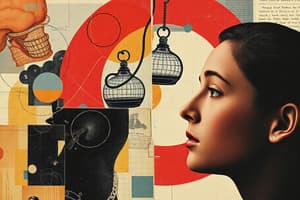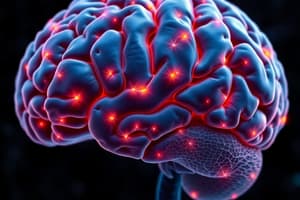Podcast
Questions and Answers
Which of the following is NOT a function of the prefrontal cortex?
Which of the following is NOT a function of the prefrontal cortex?
- Sequencing of actions
- Sensory processing (correct)
- Motivation
- Executive function
Based on the provided information, which brain structure plays a crucial role in conscious thoughts?
Based on the provided information, which brain structure plays a crucial role in conscious thoughts?
- Frontal Lobe (correct)
- Broca's Area
- Motor Strip
- Amygdala
The 'ventromedial prefrontal' subdivision of the frontal lobe is primarily involved in what?
The 'ventromedial prefrontal' subdivision of the frontal lobe is primarily involved in what?
- Motor control
- Emotions (correct)
- Language processing
- Cognitive processes
Which of these options are included in the 'motor responses of fear' as described in the content?
Which of these options are included in the 'motor responses of fear' as described in the content?
According to the provided information, what does DLPFC stand for?
According to the provided information, what does DLPFC stand for?
What is the relationship between dopamine and motivation?
What is the relationship between dopamine and motivation?
What is the role of norepinephrine in the 'fight or flight' response?
What is the role of norepinephrine in the 'fight or flight' response?
What are the potential consequences of reduced dopamine levels?
What are the potential consequences of reduced dopamine levels?
What is the primary function of epinephrine?
What is the primary function of epinephrine?
What does the term 'anhedonia' refer to?
What does the term 'anhedonia' refer to?
What are some examples of situations where dopamine release might contribute to behavioral addictions?
What are some examples of situations where dopamine release might contribute to behavioral addictions?
What is the primary location of the cell bodies producing norepinephrine?
What is the primary location of the cell bodies producing norepinephrine?
What effect does activation of the left ventromedial prefrontal cortex (VMPFC) have on mood?
What effect does activation of the left ventromedial prefrontal cortex (VMPFC) have on mood?
Which neurotransmitter is primarily synthesized from tryptophan?
Which neurotransmitter is primarily synthesized from tryptophan?
What might result from lesions to the right ventromedial prefrontal cortex (VMPFC)?
What might result from lesions to the right ventromedial prefrontal cortex (VMPFC)?
How does the brain typically regulate thought, emotion, and behavior?
How does the brain typically regulate thought, emotion, and behavior?
What is a common clinical application for treating depression involving the prefrontal cortex?
What is a common clinical application for treating depression involving the prefrontal cortex?
What role does serotonin primarily serve in the body?
What role does serotonin primarily serve in the body?
Which of the following is a consequence of low serotonin levels in the cerebrospinal fluid?
Which of the following is a consequence of low serotonin levels in the cerebrospinal fluid?
What is a common misconception about serotonin's classification?
What is a common misconception about serotonin's classification?
What psychiatric disorder is associated with abnormal serotonin levels and disgust?
What psychiatric disorder is associated with abnormal serotonin levels and disgust?
Which drug class mentioned reduces the effects of epinephrine?
Which drug class mentioned reduces the effects of epinephrine?
What emotional state is NOT associated with low serotonin levels?
What emotional state is NOT associated with low serotonin levels?
In which area of the brain are serotonin-producing cell bodies primarily found?
In which area of the brain are serotonin-producing cell bodies primarily found?
Which of the following symptoms is linked to low serotonin levels?
Which of the following symptoms is linked to low serotonin levels?
What effect does drinking coffee have on epinephrine and norepinephrine levels?
What effect does drinking coffee have on epinephrine and norepinephrine levels?
Which neurotransmitter pathway is primarily involved in the cognitive, negative, and affective symptoms of schizophrenia?
Which neurotransmitter pathway is primarily involved in the cognitive, negative, and affective symptoms of schizophrenia?
What is the nature of delusions as described in the content?
What is the nature of delusions as described in the content?
What class of drugs targets the dopamine receptor to manage symptoms of psychotic disorders?
What class of drugs targets the dopamine receptor to manage symptoms of psychotic disorders?
Among the following, which is a cause of drug-induced psychosis?
Among the following, which is a cause of drug-induced psychosis?
What is the role of adenosine in relation to epinephrine and norepinephrine?
What is the role of adenosine in relation to epinephrine and norepinephrine?
In the context of schizophrenia, what does hypoactivity of dopamine neurons in the mesocortical dopamine pathway result in?
In the context of schizophrenia, what does hypoactivity of dopamine neurons in the mesocortical dopamine pathway result in?
Which of the following is NOT a target neurotransmitter for illicit drugs?
Which of the following is NOT a target neurotransmitter for illicit drugs?
Which area of the brain is primarily associated with the control of motor function and movement?
Which area of the brain is primarily associated with the control of motor function and movement?
Which neurotransmitter is linked to the regulation of mood, depression, and anxiety?
Which neurotransmitter is linked to the regulation of mood, depression, and anxiety?
What is the primary function of the mesolimbic dopamine pathway?
What is the primary function of the mesolimbic dopamine pathway?
Which structures of the limbic system are specifically mentioned as being important for basic drives and emotions?
Which structures of the limbic system are specifically mentioned as being important for basic drives and emotions?
Which prefrontal cortex area is primarily involved in affective symptoms related to schizophrenia?
Which prefrontal cortex area is primarily involved in affective symptoms related to schizophrenia?
What type of symptoms are predominantly linked to hypoactivity of the mesocortical dopamine pathway?
What type of symptoms are predominantly linked to hypoactivity of the mesocortical dopamine pathway?
What effect do norepinephrine levels have on the body?
What effect do norepinephrine levels have on the body?
Which brain region is primarily involved with higher emotions?
Which brain region is primarily involved with higher emotions?
What is a primary role of the dopaminergic system in relation to addiction?
What is a primary role of the dopaminergic system in relation to addiction?
How does the dysregulation of neurotransmitters affect emotional states?
How does the dysregulation of neurotransmitters affect emotional states?
Flashcards
Prefrontal Cortex
Prefrontal Cortex
The most anterior part of the frontal lobe, responsible for executive functions like planning, motivation, attention, and sequencing actions.
Dorsolateral Prefrontal Cortex (DLPFC)
Dorsolateral Prefrontal Cortex (DLPFC)
A part of the prefrontal cortex that plays a vital role in focusing, remembering instructions, and managing information.
Motor Strip
Motor Strip
A region in the brain that helps plan and execute movements. It is located in front of the prefrontal cortex.
Amygdala
Amygdala
Signup and view all the flashcards
Periaqueductal Gray (PAG)
Periaqueductal Gray (PAG)
Signup and view all the flashcards
Right Temporal Lobe
Right Temporal Lobe
Signup and view all the flashcards
Ventromedial Prefrontal Cortex (VMPFC)
Ventromedial Prefrontal Cortex (VMPFC)
Signup and view all the flashcards
Left vs. Right VMPFC
Left vs. Right VMPFC
Signup and view all the flashcards
Serotonin
Serotonin
Signup and view all the flashcards
Dopamine
Dopamine
Signup and view all the flashcards
Low Dopamine
Low Dopamine
Signup and view all the flashcards
Epinephrine
Epinephrine
Signup and view all the flashcards
Norepinephrine
Norepinephrine
Signup and view all the flashcards
Reward Pathway
Reward Pathway
Signup and view all the flashcards
Anhedonia
Anhedonia
Signup and view all the flashcards
Addictive Substances
Addictive Substances
Signup and view all the flashcards
Major Depressive Disorder (MDD)
Major Depressive Disorder (MDD)
Signup and view all the flashcards
Raphe nuclei
Raphe nuclei
Signup and view all the flashcards
Serotonin and Suicide
Serotonin and Suicide
Signup and view all the flashcards
Sympatholytic Drugs
Sympatholytic Drugs
Signup and view all the flashcards
Beta Blockers
Beta Blockers
Signup and view all the flashcards
Depression
Depression
Signup and view all the flashcards
Obsessive Compulsive Disorder (OCD)
Obsessive Compulsive Disorder (OCD)
Signup and view all the flashcards
Panic Disorder
Panic Disorder
Signup and view all the flashcards
Delusions
Delusions
Signup and view all the flashcards
Delirium
Delirium
Signup and view all the flashcards
Neurotransmitters
Neurotransmitters
Signup and view all the flashcards
Mesolimbic Dopaminergic Tract
Mesolimbic Dopaminergic Tract
Signup and view all the flashcards
Mesocortical Dopamine Pathway
Mesocortical Dopamine Pathway
Signup and view all the flashcards
Dopamine Receptor Antagonists (DRA)
Dopamine Receptor Antagonists (DRA)
Signup and view all the flashcards
Stimulants
Stimulants
Signup and view all the flashcards
Nigrostriatal Dopamine Pathway
Nigrostriatal Dopamine Pathway
Signup and view all the flashcards
Limbic System
Limbic System
Signup and view all the flashcards
Mesolimbic Dopamine Pathway
Mesolimbic Dopamine Pathway
Signup and view all the flashcards
Classic Mesolimbic Dopamine Hypothesis of Positive Symptoms of Schizophrenia
Classic Mesolimbic Dopamine Hypothesis of Positive Symptoms of Schizophrenia
Signup and view all the flashcards
Study Notes
Introduction
- Emotions, thoughts, and behaviors are brain functions
- Brain has structures for normal and abnormal functions
- Disturbances in these are common psychiatric symptoms
- The brain contains 100 billion neurons with trillions of connections
Thought and Frontal Lobe
- Frontal lobe is crucial for conscious thoughts and higher-level cognitive functions
- Prefrontal cortex (PFC) is the most anterior part of the frontal lobe
- Executive functions (motivation, attention, action sequencing) are largely associated with the DLPFC
- The frontal lobe also has motor areas, including the motor strip and Broca's area
Frontal Lobe Syndrome
- Damage to the frontal lobe can cause slowed thinking, poor judgment, social withdrawal, apathy, and disinhibition
- Conditions associated with frontal lobe problems include schizophrenia, traumatic brain injury, frontotemporal dementia, and Alzheimer's disease
- The case of Phineas Gage demonstrates how frontal lobe damage can alter personality and executive functions
Emotion
- Prefrontal cortex regulates higher emotions
- Limbic system controls basic drives like feeding, sex, reproduction, pleasure, fear, and aggression
- Key structures of the limbic system include thalamus, cingulate gyrus, fornix, amygdala, and hippocampus
- Amygdala plays a significant role in fear response and related behaviors
Neurochemistry
- Neurotransmitters are crucial in communication between neurons
- Serotonin: Regulates mood, appetite, and other functions. Low levels can be associated with depression.
- Epinephrine and norepinephrine: Contribute to the "fight or flight" response, causing anxiety symptoms.
- Dopamine: Plays roles in reward, motivation, and salience attribution. Imbalance contributes to psychosis.
Temporal Lobe
- The Left temporal lobe may be involved in Philosophical thinking, and less emotional responses, while the Right temporal lobe might be tied to Emotional intensity, such as sadness and joy
- Bilateral temporal lobe activity could contribute to hyposexuality, and changes in emotional responses.
- The temporal lobe plays a role in emotion
Prefrontal Cortex and Emotions
- Ventromedial Prefrontal Cortex (VMPFC): linked to emotions, particularly mood regulation; its activity patterns may play a role in depression and excessive crying
- The specific role of the left and right VMPFC could be in opposite directions
Neurotransmitters
- Neurotransmitters are chemicals that enable communication between neurons
- Serotonin, norepinephrine, and dopamine are vital for normal thought, behavior, and emotion. Dysregulation contributes to psychiatric disorders
Summary
- Thoughts, emotions, and behaviors are functions of specific brain regions
- The frontal lobe, the prefrontal cortex, and the limbic system interact to regulate cognitive and emotional processes.
- Neurotransmitters have important roles in brain functioning and psychiatric conditions.
Studying That Suits You
Use AI to generate personalized quizzes and flashcards to suit your learning preferences.




